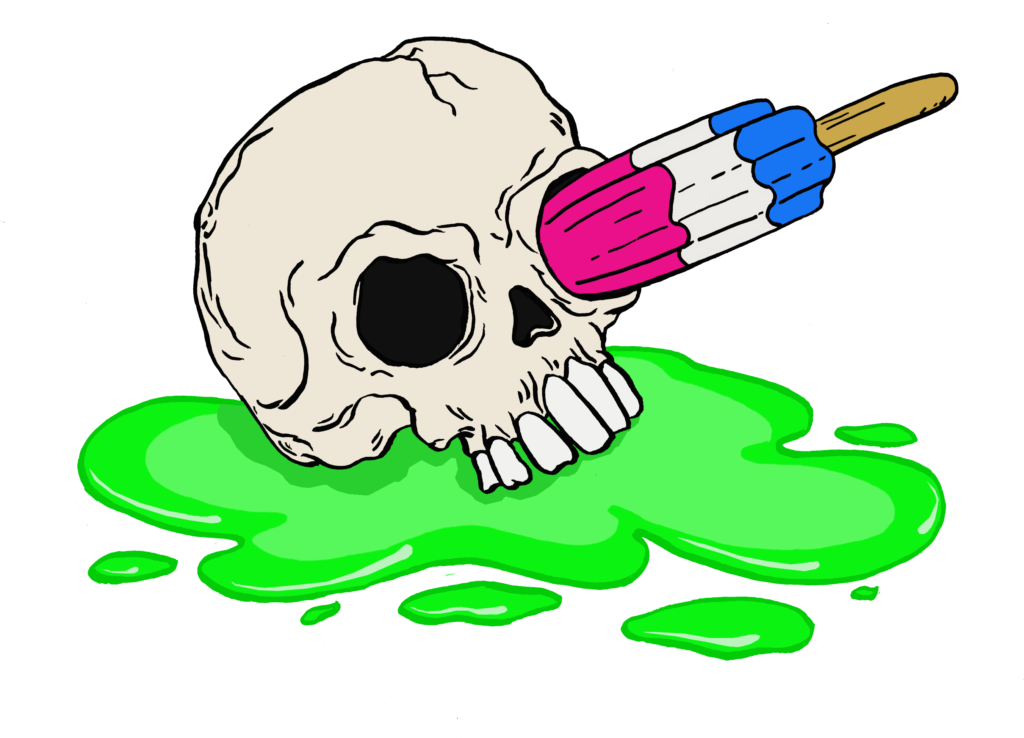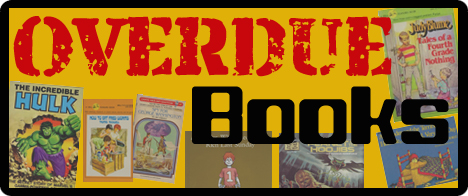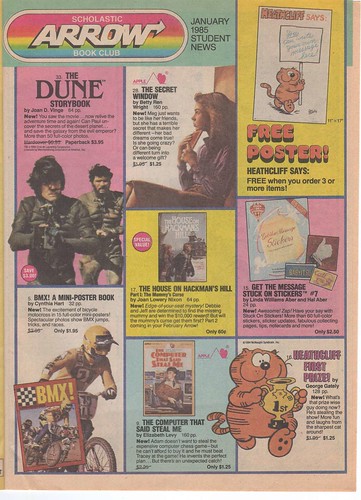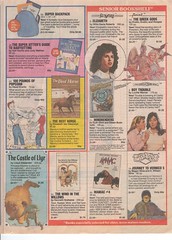This week brings yet another set of vintage book club flyers from the 80s, though sadly it’s also the last. So far I’ve covered the Troll and Weekly Reader flyers, and for this last installment I’m going to take a look at the largest of the various clubs, Scholastic. As I mentioned last week Scholastic was the last book club company standing after the various mergers and acquisitions over the past decade, most likely because they’re not just a book distributor, but also a publishing house as well. Another way that the Scholastic book club set itself apart was by really developing its branding. Though both Weekly Reader and Toll had different catalog flyers aimed at the various grade and age groups in public school, Scholastic differentiated these flyers by issuing them under unique brand names. For instance, the grades 4-6 received the Arrow book club flyers, while middle school and high school students received copies of the TAB club flyer. This splintering of the main brand was just one of the ways that Scholastic tried to stay relevant to students, who would quickly outgrow the various clubs and would be looking for stuff that appeal to them and seemed more tailored.
Like Weekly Reader, the Scholastic book club flyers came bound inside a monthly educational newsletter. This was where you got a chance to see the main company branding as the handout was called the Scholastic News…
Another way that Scholastic set itself apart from the other clubs was by offering back-issues of their entertainment magazines like Dynamite, Hot Dog, Maniac, and Bananas. Actually, I didn’t see any full-on subscriptions for these magazines in the book club flyers below, so I wonder if this was the only way to get access to these magazines to begin with. I don’t remember seeing any of them on the newsstands or spinner racks growing up. Maybe Scholastic would hook you by offering up an issue each month and then you could get the exclusive subscription mailer inside of the actual magazine. Anyone out there remember subscribing to any of these or finding them outside of the Scholastic book club flyers?
Anyway, for this last vintage book club article I have four more flyers to share from the collection of Esteban, who runs the awesome Roboplastic Apocalypse. Three of them are from the Arrow club which was handed out to grades 4-6, and the last one is from the TAB club which was handed out to the 7th-12th grade students. First up is the January 1985 issue of Arrow…
So after looking through a number of these book club flyers from the various companies I have to say that I am surprised by the gusto with which Heathcliff was advertised compared to Garfield. In the battle of the little orange tabby cats, Heathcliff always comes out on top (front and center, page one) of these book club flyers. I wonder if the various companies sold flyer space like ad space is sold in newspapers? If so, Ace books sure were willing to shell out a shinier dime than Ballintine. Either that or because Garfield was most likely much more popular in brick and mortar stores, the company didn’t feel the need to compete in these school book club flyers…
I also thought it was interesting, from a design standpoint, that the guys and gals that worked on these Arrow flyers chose to highlight the publisher imprint logos on a lot of these book listings. So when you see a listing for a Twist-a-Plot book like the one on the 3rd page of the flyer above, the T-a-P logo was separated out and placed at the top of the blurb. I know I was always on the lookout for specific branding when it came to books, as even at a young age I was responding to the various publisher and series logos. Again, it’s another in a long line of examples in how Scholastic was trying harder to reach these kids (and in turn reaching into their parent’s wallets…)
There are a couple of cool books in this first flyer, in particular Robot Race which was part of the Micro Adventures series of paperbacks that were trying for a sense of interactivity back in the day. Instead of letting the reader guide the story as in a Choose Your Own Adventure style book, the Micro Adventures stories featured BASIC style computer programs printed through out the book that he reader could program into their home computing systems to play games and solve problems from the story. I’m amazed at just how many ways the writers and publishers of the 80s were trying to heighten the reading experience for kids.
As I mentioned above, there were a handful of entertainment magazines published by scholastic in the 70s and 80s, two of which were available in this flyer, Maniac (aimed at high school kids that were in tune with the MTV generation), and Dynamite (which I’ve written about before.)
The first thing that jumped out at me in this February 1985 flyer is the rock and roll themed poster/sticker sheet combo. Stickers were typical of these flyers, but I’ve never seen a sheet that listed the artist and gag writer before. Apparently R.L. Stine (of Goosebumps fame and who often whet by Jovial Bob Stine) got together with B.K. Taylor (the artist for the Awesome All*Stars! sticker cards as well as a regular feature artist in the pages of Hot Dog and Dynamite) and whipped up a sheet of rock inspired stickers. I’m guessing that they were featured because they both worked at Scholastic on the various magazines, but it’s still a little weird…
This May 1985 flyer is also pretty interesting as it’s an example of the end of the school year edition. Since the kids would be out of school in the first week or so of June, May was the last good chance Scholastic had to sell some swag, and I think it’s interesting that they eschewed the standard flyer for a two page blow-out sale…
Though I don’t remember the Arrow book club, or any of these end-of-the-year blowouts, being the bargain shopper that I am I think I would have flipped for the flyer in May of ’85. In particular I would have really dug picking up multipacks of the Micro Adventures and Twist-a-Plot series all for the price of one book. It even appears that there was some really old stock being pushed, as the 1983 Return of the Jedi storybook was bundled with a 1980 Empire era poster of Darth Vader. I know for a fact that there was a metric ton of overstock on this particular Jedi story book as I’ve consistently seen brand new copies of this book in dollar stores and overstock book stores over the last 20 years.
The last vintage book club flyer I have to share is from the Scholastic imprint called TAB which was aimed at 7th graders and above. This particular edition is from February of 1987 and barely survived to be shared…
My first impression of this flyer is that it’s sort of schizophrenic in its odd mixture of offerings. On the one hand there are some more adult fare like teen romance novels, classics (such as the Count of Monte Crisco, Animal Farm, Lord of the Flies and Dracula), and books on writing term papers, but on the other there are still kid oriented books (like one about race cars) and sticker collecting kits. Then again, when I think back to my 7th grade days I know I was going through a similar period of weird reading habits, bouncing back and forth between thousand-page Stephen King epics and cracking open Judy Blume’s Tales of a Fourth Grade Nothing for the umpteenth time. I guess the 7th grade really does mark an awkward transition period for children. Most are turning thirteen, and depending on individual predilection, most are probably also facing that time when it isn’t cool to collect toys, read comic books, or bring your lunch to school in a lunchbox anymore. I know that I personally rebelled against the idea that these things had to stop, but I was also far from popular…
As a special bonus, friend of the site Jose Anibal Gonzalez (who has a great art blog by the by), went above and beyond and sent in a scan of his daughter’s current Scholastic book club flyer from this past January. It’s the perfect way to end this series as we can see how these flyers have changed over the last quarter century. Thanks Jose!























